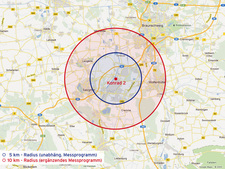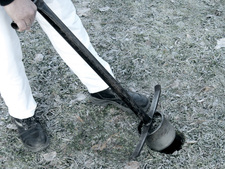Additional program started for environmental monitoring near Konrad
It will take some years for the Konrad repository to be taken into operation. According to legal requirements, the vicinity of Konrad needs to be monitored two years before the first radioactive waste will reach the repository. Despite of that, the BfS has taken up environmental monitoring of Konrad’s vicinity much earlier and has even extended the monitoring upon request of the Lower Saxon Farmers’ Association.
Being the operator, the Federal Office for Radiation Protection (BfS) must prove that the limits for the population and the staff set out in the provisions of the Radiation Protection Ordinance are complied with. For discharges (waste water and exhaust air) and direct radiation resulting from the repository operation the limit value is 1 millisievert per year. That is about half of the natural radiation exposure each person living in the Federal Republic of Germany is exposed to per year on average. However, experiences made in other companies show that this value is actually clearly fallen below.
Monitoring of waste waters, air and plants

![]() In a radius of up to 10 kilometres various samples are taken and examined for their radionuclide concent
In a radius of up to 10 kilometres various samples are taken and examined for their radionuclide concent
Already before the Konrad repository will be taken into operation, all discharges will be recorded and controlled. This is prescribed by the “Guideline for the emission and immission monitoring of nuclear facilities” (REI). Thus, samples will be taken from waste waters which will then be measured, the same applies to the exhaust air from the shaft or the plants growing in the vicinity of Konrad. This will be done by the operator and, at the same time, by an independent measuring agency. This way, the actual exposure due to the repository can be verified by means of comparative figures.
Lower Saxon Farmers’ Association wishes more samples to be taken
Many farmers in the vicinity are concerned that their produce could be radiologically contaminated through the repository. Therefore, the Lower Saxon Farmers’ Association requested the BfS to supplement the environmental monitoring of Konrad by another measurement program. The BfS has now complied with this request by commissioning another institute (IAF – Radioökologie GmbH), a laboratory for radionuclide analysis.
Larger monitoring radius, more samples
According to REI, the monitoring radius for the measurement program is limited to five kilometres. On the other hand, the supplementary measurement program processes samples from a radius of ten kilometres. It is legally prescribed that samples of soil, grass, grain, milk, vegetables, fruit, water and air be taken. Furthermore, the IAF will also take samples of corn, rape, sugar beets, needles/foliage and woodruff. In addition to the prescribed 58 samples per year according to REI, another 195 samples will now be taken and evaluated by the independent measurement institute IAF.
Measurement program started in 2012
The additional measurement program started in January 2012. The first measurement cells have already been set up. Farmers and private persons can volunteer to have their samples evaluated. Contact: info@bfs.de
State of 2012.02.10


